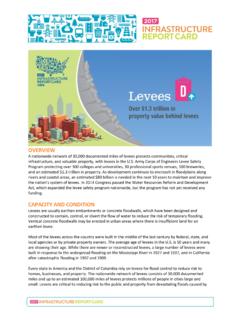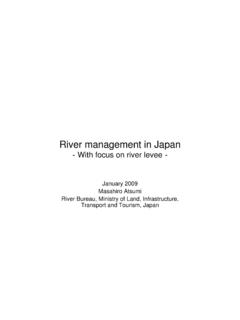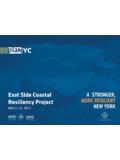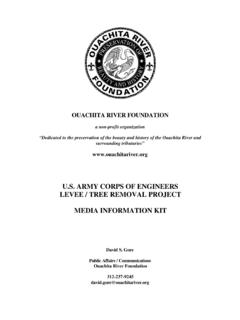Transcription of CENWP-EC DEPARTMENT OF THE ARMY PDR 1130-2-5 …
1 CENWP-EC DEPARTMENT OF THE ARMY PDR 1130-2-5 . Portland District, Corps of Engineers (Draft). Box 2946. Portland, Oregon 97208. Regulation 18 August 2009. NO. 1130-2-5 . Operations and Maintenance LEVEE ENCROACHMENT STANDARDS AND PROCEDURES. 1. Purpose. This regulation provides technical guidelines related to levee encroachments and the fulfillment of local agency maintenance obligations specified in Part , Title 33, Code of Federal Regulations (CFR) and will help insure that the integrity of a levee system is maintained in situations where a proposed levee encroachment is considered to be in the public interest.
2 This regulation also provides design guidelines for implementation of such encroachments. 2. Applicability. This regulation is applicable to all Divisions within the Portland District having civil works responsibilities. 3. References. a. EM 1110-2-301, Guidelines for Landscape Planting and Vegetation Management at Floodwalls, levees , and Embankment Dams (1 January 2000). b. EM 1110-2-1419, Hydrologic Engineering Requirements for Flood Damage Reduction Studies (31 January 1995). c. EM 1110-2-1908, Instrumentation of Embankment Dams and levees (30 June 1995).
3 D. EM 1110-2-1913, Design and Construction of levees (30 April 2000). e. EM 1110-2-2502, Retaining and Flood Walls (29 Sep 1989). f. EM 1110-2-2705, Structural Design of Closure Structures for Local Flood Protection Projects (31 March 1994). g. EM 1110-2-3102, General Principles of Pumping Station Design and Layout (28. February 1995). h. EM 1110-2-3104, Structural and Architectural Design of Pumping Stations (30. June 1989). 1. i. ER 1130-2-530, Flood Control Operations and Maintenance Policies (30 Oct 1996). j. ER 1110-2-1401, Operation, Maintenance, Repair, Replacement and Rehabilitation Manual for Projects and Separable Elements Managed by Project Sponsors, (30 Apr 1994).
4 K. ER 1110-2-1405, Hydraulic Design for Local Flood Protection Projects (30 Sep 1982). l. ER 1110-1-1807, Procedures for Drilling in Earth Embankments (01 March 2006). m. ER 1110-2-1942, Inspection, Monitoring and Maintenance of Relief Wells (25. Sep 1998). n. 33 CFR Sec. , Title 33, Chapter II, Part 208, Federal Flood Control Works Maintenance Requirements o. Levee Owner's Manual for Non-Federal Flood Control Works, The Rehabilitation and Inspection Program, PL 84-99, March 2006. 4. General. Adequate levee maintenance and control of levee encroachments are essential in maintaining levee stability and assuring maximum safety for protected areas.
5 Urbanization, increased river recreation use, and environmental construction restrictions on navigable waterways have created public pressure to construct utility lines, buildings, and boating facilities on, across, adjacent to and through existing levee embankments and rights-of-ways. Uncontrolled levee encroachments weaken a levee system. Defined standards and technical requirements for construction of encroachments are considered a necessity to establishing a well maintained, high performance levee system. 5. Policy. The standards and procedures presented in ER 1130-2-530 and the provisions included in this regulation will be followed in performing permit reviews and inspection evaluations for levee systems within the Portland District.
6 Special attention will be given to construction of encroachments, such as utility lines, buildings and appurtenant levee structures, and the guidelines in this District regulation followed in providing technical assistance to Drainage Districts and local agencies in design of new projects and for levee permit or inspection recommendations. 2. Centerline Riverward Landward Zone D Zone B Zone C. Zone C Zone A Zone D. MINIMUM LEVEE SECTION. Note: See Appendix A for Details FIGURE 1. 6. Levee Encroachments. The policy regarding levee encroachments will be to permit in the levee section only those appurtenant installations that provide a flood control function during high river stages and heavy storm conditions.
7 Exceptions to this policy will be allowed in cases where the function of the encroachment is considered to be in the public interest and where adequate provisions can be made to maintain the integrity of the levee system. In order to establish guidelines for levee encroachments, several conditions for agricultural and urban levee systems are presented in Appendix A. Figures1 through 8 of the appendix show minimum section and zone restriction requirements for encroachments. For the purpose of establishing, presenting and illustrating these guidelines, the levee embankment section and adjacent area have been divided into four zones, A through D as shown on Figure 1.
8 More detailed standards for common levee encroachments are as follows: a. Levee Landscaping. A good growth of sod will be encouraged on unrevetted levee slopes. Vegetation producing heavy foliage or root systems capable of penetrating into Zones A, B, and C will not be permitted. On landfill or levee overbuild sections, sparsely spaced trees and other deep root landscaping will be permitted provided a root-free zone having a minimum depth of 3 feet is maintained over the underlying levee embankment zones. b. Fences. Fences required to prevent animal grazing on the levee section will be restricted to Zone D.
9 A 10-foot minimum width access way will be maintained between the toe of levee slope and the fence row. 3. c. Utility Poles. Utility poles will be restricted to Zones B and C, except for the Zone A. utility poles required at pumping stations. Pumping station poles, located in Zone A, will be located within the limits specified in figures 1 and 5 of Appendix A. d. Buried Cables. Buried power and telephone cables will be allowed in Zones A, B, and C. Cables located in Zone A will be restricted to the freeboard portion of the levee embankment.
10 E. Gravity Conduits and Pipes. In general, tide box structures and sewer lines are the only gravity flow installation allowed t o pass through the minimum levee section below maximum flood stage. Where possible, small gravity flow pipes will cross through the freeboard or overbuild portion of the levee embankment. Lines parallel to the levee centerline will not be allowed in the minimum levee section. (1) Tidebox Structures. Minimum levee section requirements and guidelines for selection of the river closure system (Appendix B) will be given special attention for all tidebox installations and only those encroachments necessary for proper operation of the tidebox will be allowed.






